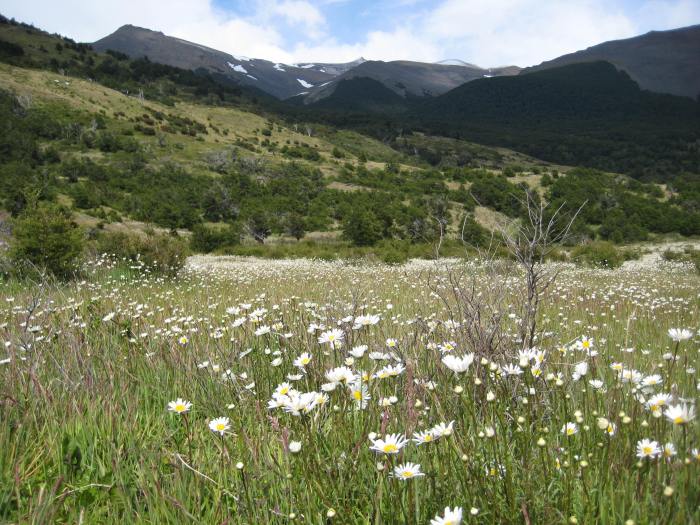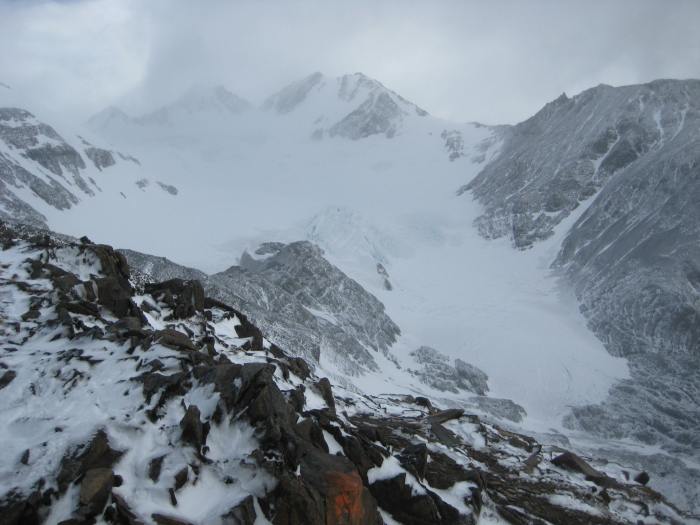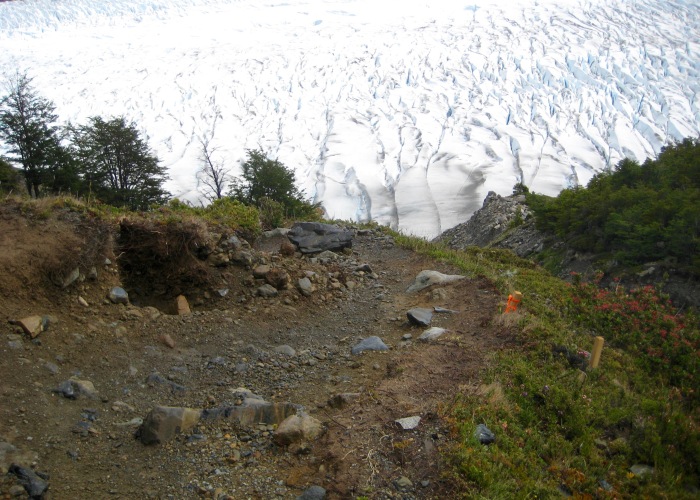“DAMN IT, UGH!” I cried out in frustration after being lifted by the wind and thrown against the rocks for the umpteenth time on Gardner Pass. I had been inching forward up the pass for nearly two hours with snowflakes stabbing my eyes and intense winds intermittently thrashing me backwards and sideways. I squinted in a futile attempt to protect my eyes, as I searched up the pass for the next orange post that marked the trail. The insanity of the conditions and my painfully slow progress triggered an urge to cry; after a lengthy inner dialogue my rational side won out; crying accomplishes nothing and I simply couldn’t spare the energy. I turned my entire focus to incrementally moving forward. Summer weather in Patagonia can be atrocious.
On the southern end of South America, Chile and Argentina share the region of Patagonia. It is sparsely populated by people but plentiful in wildlife unique to the area. I frequently saw herds of three-foot tall camelid guanacos, small ostrich-like birds called rheas, and Andean Condors sporting wingspans of up to 10 feet. The Andes Mountains, steppes, grasslands, and deserts fill this space flanked by the Pacific and Atlantic oceans. In Chile, near the town of Puerto Natales, is Torres del Paine National Park – a phenomenal natural playground for climbers, trekkers, and runners. There were 14 runners on our Patagonia Running Adventure with a company named Andes Adventures. The Torres del Paine Circuit – also called the “O” for its shape – was one of the highlights of our trip.
Trekkers typically take seven to nine days to complete the roughly 75-mile Circuit. The fastest known time was 16 hours and 20 minutes achieved by elite ultra-runner Jason Schlarb in January 2014. Our itinerary was less ambitious dividing the circuit into five legs. The first was a short out-and-back from Hotel Las Torres, where we spent our first night in the park, to see the three giant granite towers for which the park was named. Torres is Spanish for “towers”; Paine is from the native Tehuelche word meaning “blue”.

Andes Adventures had reserved meals, bunks, and bedding for us at three Refugios which eliminated the need to carry sleeping bags, shelter, and meals for the next four days. Our personal packs held snacks, extra running clothes, light clothing to wear inside the Refugios, rain gear, and toiletries. It was safe to drink the water directly out of the streams in Torres del Paine and opportunities to refill our 20-ounce bottles were plentiful.
The leg from Hotel Las Torres to Refugio Dickson was 18 miles of undulating terrain. We saw teal blue glacial lakes, open fields of daisies, and distant mountain peaks. We started our run in a chilly breeze under mostly sunny skies. Later, dark clouds lurked in the distance and the wind picked up so hard that while skirting along a ridge my hat was ripped from my pack and sent flying forever out of reach. We hustled past a trekking group from the UK as we descended to Refugio Dickson determined to get our share of the hot water before the rest of the crowd arrived.

Our instincts proved to be accurate. When we arrived at Dickson there were only two functioning showers to serve the 30-40 campers and Refugio guests. Feeling more grimy than modest I slipped into one of the showers knowing there was a man in the neighboring stall. I figured the relaxed European modesty standards would prevail in this situation, but the gentleman was Latino and seemed deeply chagrined when he found himself sharing the space with a woman. Later, we made eye contact across the crowded dining room and gave each other a slight nod and tiny smile.

Our running group occupied all the beds in Refugio Dickson. The rest of the guests slept in tents on the designated campgrounds. I shared a bunk room next to the common area with five other women; there was a men’s bunk room and a few private rooms upstairs. The dining room was for all to share and the kitchen crew efficiently served everyone in shifts. We shared stories and bottles of wine into the late evening hours. The dry humor of the Brits combined with liberal servings of wine made for an escalating volume of conversation and laughter. Knowing we had to get up early the next morning, I hoped the noise would die out at a reasonable hour. Thankfully, the Refugio quieted down by 10:00; the kitchen closed and the electricity was turned off.
The timing of our trip, near the Summer Solstice, offered 18 hours of daylight – plenty of time to get to the next Refugio. On Christmas Eve at 7:00 a.m. our group embarked on the most challenging leg of the circuit – an 18-mile stretch between Refugios Dickson and Grey that included 3,937-foot Gardner Pass. At home in Colorado this elevation would be lower than the forested foothills, but because Torres del Paine is so far south of the equator we would be well above the tree line at that elevation and exposed to Patagonia weather conditions notorious for random spells of nastiness.
Standing outside Refugio Dickson in the morning drizzle, we listened to our instructions. Our group consisted of experienced trail runners ranging in age from 20’s to 60’s. We were prepared to be strung out from each other and out of contact with our guides most of the day. Our leader was adamant about one point: “Stop at the Los Perros campground shelter. Put on all of your rain gear and perhaps an extra layer for warmth,” he said, “Eat your lunch – even if you don’t feel hungry — because it will be a long time before you can eat again.” He said this at least twice. Los Perros was clearly our last chance for shelter before the final push up Gardner Pass and the weather forecast was ominous.
As we ran up through the beech tree forest toward Los Perros the trail alternated between forested muddy stretches and steep open rocky climbs. Wooden bridges offered dry crossing over gushing glacial streams. High snow fields peeked out through low hanging clouds. The air temperature dropped and a frigid wind chilled our ears. The last quarter mile into the campground was lined with small stones but it was unclear exactly where the shelter was located. As we wandered the grounds looking for the shelter, we spotted the first two members of our group continuing up the trail. They said they didn’t need to stop; they weren’t hungry; and moreover, they had chosen not to carry rain pants.
My partner and I had plenty of experience braving harsh conditions in the Colorado mountains above tree line and respected the guide’s warning that the weather could get gnarly. Stopping to eat and don our rain gear was never in question even though it was still mid-morning and we were feeling relatively fresh on our legs. We joined some trekkers in the shelter and sat down to eat lunch packed for us by the kitchen staff of Refugio Dickson. I opened the warm foil and discovered a fish sandwich made using fresh quinoa pancakes instead of bread; I was extremely grateful for the extra effort the cooks made to accommodate my gluten intolerance. Despite sitting in the enclosed shelter, I began to get chilled and decided to add an extra layer under my rain gear. Thankfully, a fellow runner had loaned me her spare hat to replace the one I lost.
We set off up the steep, slippery, muddy trail squeezing past a few trekkers weighed down by their packs. There were unavoidable sections of trail where we sank up to our ankles in mud. When we emerged from the trees, it was snowing lightly and the trail traversed across a snow field. I noticed the two frontrunners of our group up the mountain on the left, about 100 meters off the trail. They were sitting down. It seemed odd since they left Los Perros at least a half hour before us. We yelled up to them, pointing in the direction of the trail. Our main guide caught up to us at that point and became concerned when the two runners didn’t budge. He told us to go on and he would take care of the situation. Later, we learned, they had stopped because they were hungry, cold, and discouraged; they thought they were lost. After eating some lunch their energy returned; they changed into dry socks and warmed up when they got moving again. The brain fog that comes with low blood sugar can lead to dire consequences in the mountains; they were lucky they had stopped within sight of the trail.
As we rounded a bend on a low ridge above a river, we were suddenly slammed by a ferocious head wind. Trekkers, unable to stand up due to their larger packs catching the brunt of the wind’s force, deliberated over whether to turn back. I crouched low, and moved forward as fast as I could between surging gusts. The inconsistency of the wind velocity made it difficult to maintain my balance. Even crouching low, I found myself repeatedly knocked to the ground onto my knee or my hip.
The blowing snow created thigh deep drifts; our feet sank through and were soaked in icy cold streams of water. We encountered more floundering trekkers struggling in the deep drifts and intense wind. Because we didn’t have to carry so much gear, the runners had an advantage against the fierce winds. We trudged by the trekkers, made sure they were all right, and wished them luck.
A man coming down from the pass approached me and in crystal clear English said “The pass is closed”. I was confused. How do they close a pass? I briefly envisioned a locked gate. With the wind howling in our ears we had a shouting conversation where he was speaking Spanish and I was speaking English, neither one of us knowing what the other saying. But his message was clear when he pointed up to the sky, drew a circle in the air, and then pointed behind me down the trail.
I argued with him, telling him we were strong, traveling light, and needed to go forward, not back. Our next food and lodging were on the other side of the pass. We had nothing to go back to: no sleeping bags, no shelter, no food. In obvious frustration, the man waved me on, with a look on his face that said “I don’t have time for this idiocy, just go!” By the time this interchange ended, my partner had caught up to me and asked what it was about. I answered, “Just some guy who didn’t think we could make it over the pass.” We continued uphill into the howling wind. As the wind intensified, my partner and I became focused on our own personal battle with the elements. We had visual contact but were separated enough that communication was impossible. The rest of our group was nowhere in sight. I wondered about my sanity and worried about the safety of my running mates who were all strung out behind us.

At the top of the pass, there were prayer flags wildly whipping in the wind and I marveled that they weren’t torn to shreds. I wanted a photo but the risk of having my mitten snatched by the wind was too great, so I settled for the memory. I glanced back for my partner; he waved me forward. No argument there.
The wind eased up slightly on the other side of the pass and allowed us to partly run and partly slide on our feet down a snowfield following the trail of orange posts. Suddenly I noticed the clouds had parted in the distance allowing a stream of sunshine to break through and reveal the massive glacier below us – Glacier Grey. Spanning 104 square miles, it commanded nearly all my field of vision. Ghostly dark fissures gave it texture and character, and though its movement was imperceptibly slow, its presence had a lifelike quality. Chills rippled through my body.

We reached the shelter of the trees knowing we were about to experience an entirely different challenge. Our guide had referred to the next section as “the monkey trail”. This steep, slippery, muddy, winding trail required us to grab branches with our hands to help control our speed and direction down the slope. Despite the branches and strategically placed ropes and metal railings available to grab, my feet slid out from under me and I wound up careening down the hill on my butt. My rain gear was offering zero friction, and if it weren’t for the tree roots, the trail could have served as a fast and muddy bobsled course. After the recent harrowing experience on Gardner Pass I found this situation on the monkey trail to be hysterically funny.
After the monkey trail the path turned to firm rolling terrain lined with wildflowers. The sun fully emerged from behind the lingering clouds. We peeled off our layers and relaxed in the warmth and calm. Peeking through the trees was the eerie, ever-present Glacier Grey. The rest of our run was along exposed ridges and forested areas. We descended into a rocky gulch and climbed out on fixed metal ladders. The deeper gulches offered crossing via high suspension foot bridges. We passed through a large burned area from a fire that forced closure of the park four years earlier; the cause was determined to be by an irresponsible tourist.
Refugio Grey was situated near Grey Lake on the south end of Glacier Grey. In singles, pairs or threes, our group straggled in to the Refugio over the course of the afternoon. When dinner was served at 7:30 we were still missing several runners. Keeping an eye on the entrance to the Refugio we sat down to eat our Christmas Eve feast.
Conversation over dinner was dominated by traumatic stories; some members of the group were caught in a whiteout; others were delayed by rangers at Las Perros; feet had gone numb; hats were blown off; and food supplies exhausted. I told my partner about how I wanted to cry on the pass and he said “Hell, I cried!” One of the younger women was escorted by two rangers down the monkey trail; one holding her hand and the other bracing her feet so she wouldn’t slip; they gave her hot chocolate at Campamento Paso; she “friended” them on Facebook later.
Glaringly absent were the stories of our tail group of older runners. While we were lingering over dessert, I caught a glimpse of our sweep guide standing outside near the entrance of the Refugio. We rushed to the door and were relieved to see the last arrivals of our group. As I was hugging one of the women, old enough to be a grandmother, she let out with endearing candor a string of expletives to describe her ordeal on Gardner Pass. These runners had clung together and were heroically assisted by our sweep guide over the pass. We thanked him profusely. He looked exhausted.
Our guide, in his 19 years leading groups on his Patagonia Running Adventure tour, had never experienced such horrible conditions. I learned that the man who tried to turn me back was a ranger and the pass was indeed officially closed. Allowing the runners through was against the ranger’s better judgement but he acquiesced first at my stubbornness and again at the pleas from our guide who convinced him there was no viable alternative.
Christmas Eve will always trigger fond memories of that day in Torres del Paine. The vast unique landscape and the temperamental weather made me feel at once puny and strong. My running mates in their 60’s inspired me by proving age does not necessarily define a person’s drive or sense of adventure. Finally, I learned, that in the middle of summer in Patagonia you can get caught in a blizzard.





You really nailed it. Loved the pictures.
>
LikeLike
Wow, what a story – I was grinning, wincing, and ooh-aahing. Ditto on loved the pictures.
LikeLike
What an adventure, makes the Inca trail seem easy…..and it wasn’t.
LikeLike
A totally amazing Blog!! I have friends who were on that trip, Kathy and Dan. Thank you for sharing!
LikeLike
Terrible conditions, great route, excellent writing!
LikeLike